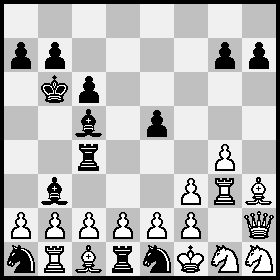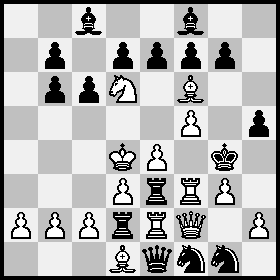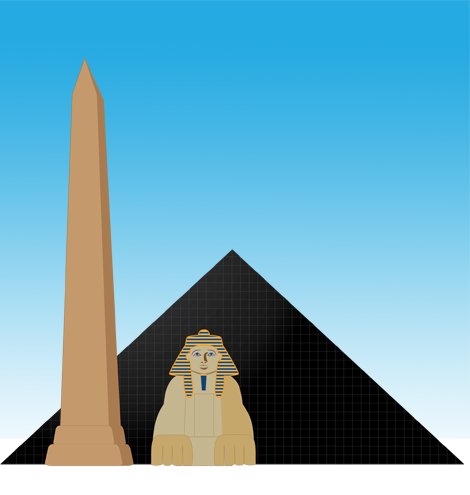Turnary Reasoning (Solution)
by Timothy Chow, Alan Deckelbaum, and Tanya Khovanova
Looking at the positions we can notice that it is not needed to find winning moves. The name turnary suggests that we should find whose turn it is. The flavor text suggest that some positions might be impossible.
Matching digits to individual puzzles is natural. 1/2 means that its first/second player turn, while 0 means the position is impossible. The table structure suggests to put numbers in rows. Solution to individual puzzles are below. Here is the result:
121 110 001 112
Converting to decimal 16, 12, 1, 14 and to letters: PLAN
The answer is: PLAN
Chess
Problem 1.
It is Player 1's (White's) turn to move.
As a preliminary step, let us show that no pawn promotions could have occurred. The only White pawn that could possibly have promoted is White's a-pawn. Black has thirteen units on the board, and thus White has made a total of three captures. Two of these are accounted for by the White pawns on f3 and g4. White's a-pawn can therefore have made at most one capture, so if it promoted, it must have promoted on a8 or b8. But this is impossible since Black's a-pawn and b-pawn are still on their original squares. Thus White did not promote. White has fifteen units on the board, so Black has made exactly one capture, namely of White's (unpromoted) a-pawn, on either the a-file or the b-file. Thus Black's d-pawn, e-pawn, and f-pawn never left their original files, and Black's c-pawn either stayed on the c-file or possibly captured onto the b-file. Any Black promotion must therefore have occurred on b8, c8, d8, e8, or f8, but this is impossible because White's b-pawn, c-pawn, d-pawn, e-pawn, and f-pawn are still on their original squares. Thus Black did not promote.
Now suppose towards a contradiction that White has just moved. The only possible piece that White could have moved last is the king, from f1 to g2 out of check. The only way Black could have delivered that check is by a discovered check, moving Ne1-g2; the White king then captured Black's knight with Kf1xg2. Thus there would have been three Black knights on the board at the same time. But this is impossible since, as we have already seen, Black did not promote any pawns.
Thus if the position is legal at all, it must be White's turn to move now. To demonstrate legality, we have to exhibit a sequence of moves leading up to the given position. The main difficulty is that White's pieces are locked up on the kingside and it is hard to see how they got there. However, it is fairly easy to see that the position in the following diagram (with Black to move) can be arrived at legally:

Starting from the above position, the following sequence of moves takes us to the given position:
| 1. | ... | Ne1-d3+ |
| 2. | Kf1-g2 | Nd3-b4 |
| 3. | a2-a3 | Nb4-a6 |
| 4. | a3-a4 | Na6-b8 |
| 5. | a4-a5+ | Kb6-b5 |
| 6. | a5-a6 | Kb5xa6 |
Problem 2.
It is Player 1's (White's) turn to move.
We first note that all the pawns are still on the board, so there have been no pawn promotions.
Of all the pieces in the lower half of the board, the last one to have moved must have been the White king, moving from e5 or g5 to f4. Let us refer to this final White king move as the "locking of the cage." Now, Black's move ...exf6 either occurred after the locking of the cage, or, at the earliest, it might have occurred immediately before the locking of the cage, delivering check to the White king and forcing an immediate Kf4. Either way, Black's dark-squared bishop could not have left its original square of f8 until after ...exf6(+) and therefore *after* the locking of the cage. But Black's rooks, king and queen all made their way to their final squares *before* the locking of the cage, when the Black bishop was still on f8 and the Black e-pawn was still on e7. Thus Black's pawn moves must all have occurred *before* the locking of the cage, in order to let Black's rooks, king, and queen out. In particular, White's missing bishop and knight were captured by Black's pawns (on b6 and f6) before the locking of the cage.
It follows that after the locking of the cage, all moves must have been made by White's knight, White's a-pawn, or Black's dark-squared bishop. On its way from f8 to a7, Black's bishop must have played Bd6-b8 or Bc7-b8 at some point, and at that moment White's knight must have been on e5 or d6 to shield the White king from check. Thus White must have moved a1-a2 immediately after Black played Bb8. Black then could only have shuttled his bishop between a7 and b8---moving an odd number of times---while White could only have moved his knight on and off the b8-h2 diagonal---moving an even number of times. Thus Black must have moved last, and it is White's turn to move, provided the position is legal at all.
To see that the position is legal, one can readily verify, for example, that the following position (with White to move) can be legally reached from the starting position:

and that a possible sequence of moves leading up to the given position is:
| 1. | Nd6-b5 | Kg4-h3 |
| 2. | Kd4-e5 | e7xf6+ |
| 3. | Ke5-f4 | Bf8-e7 |
| 4. | Nb5-d6 | Be7-d8 |
| 5. | Nd6-b5 | Bd8-c7+ |
| 6. | Nb5-d6 | Bc7-b8 |
| 7. | a1-a2 | Bb8-a7 |
| 8. | Nd6-b5 | Ba7-b8+ |
| 9. | Nb5-c7 | Bb8-a7 |
Problem 3.
This position is impossible to reach in any legal game of chess.
To see this, let us ask what the last move could have been. The only possibility is that White's king played Kc8xc7, capturing a Black bishop that had just moved Bb8-c7+. Continuing to rewind history backwards, a succession of captures (and moves by pieces that are no longer on the board now) could have occurred, but in all positions obtained by working backwards from the given position, the Black queen must be on a8, the Black king must be on e8, and the White king must be on c7 or c8, to avoid positions with impossible check. But then there is no way for White's rook to have arrived at f7, because it must have arrived via Rf8-f7, and on f8 it would have delivered an impossible check.
Problem 4.
It is Player 1's (White's) turn to move.
It is easy to find a sequence of moves leading to the given position, so the position is legal. The Black a-pawn has moved exactly once, and the White h-pawn has moved exactly once. Other than that, the only pieces that could have moved are the kings, rooks, and knights. We claim that on every move, the piece that was moved went from a dark square to a light square, or vice versa. This is always true for knights, and it is true in this position for the other pieces too because they can only ever move one square orthogonally at a time. So we can see that the total number of moves made by the White king and rooks is even (since they are back on their original squares) as is the total number of moves made by the White knights. Together with the White pawn move, this means that the total number of moves made by White is odd. Similarly, we can deduce that the total number of moves made by Black is odd. Therefore it must be White to move, because if White had just moved then the number of White moves and the number of Black moves would have opposite parity.
Checkers
Problem 1.
It is Player 2's (White's) turn to move.
Suppose that White moved last. The only candidate last moves would then be 27-23, 27-24 or 22-18. But 27-23 or 27-24 could not have been the last move because White would have had to have jumped 31-22 or 30-23 instead. If 22-18 were the last move, then the Black checker currently on 26 must have arrived via 23-26, before White moved 27-23. But then when the Black checker first arrived at 23, square 18 must have been vacant, and White would have had to have captured Black with 27-18. This is impossible. Thus White could not have moved last, and it is White's turn to move now.
This game is possible:
| 1. | 9-13 | 22-18 |
| 2. | 6-9 | 23-19 |
| 3. | 10-14 | 27-23 |
| 4. | 13-17 | 26-22 |
| 5. | 17x26 |
Problem 2.
It is Player 1's (Black's) turn to move.
There are 12 white pieces and 10 black pieces. All black pieces are in the original position except the one in position 17. Suppose Black just moved, then its move should have been 9-13, and 9 was the original position of that black piece. Then the white piece that is in position 5 now would have captured it. Contradiction. Hence it must be Black's move.
The position is possible:
| 1. | 9-13 | 24-20 |
| 2. | 10-14 | 27-24 |
| 3. | 14-18 | 23x14 |
| 4. | 5-9 | 14x5 |
Problem 3.
This position is impossible to reach in any legal game of checkers.
There have been no captures and there are no kings. In such positions it's easy to count how many moves each player has made. Black has made 8 moves and White has made 9 moves. The black starts, thus the position is impossible.
Problem 4.
It is Player 1's (Black's) turn to move.
White still has all his checkers and Black has had one checker captured. That checker could not have kinged before being captured, because there is no free path to square 31. We can count that White has made 8 moves, including one capture. WLOG we can assume that the captured black checker started in row 3. The Black checkers currently on the board have made a total of 5 moves. There's no way that the Black checker could have been captured by the White checker that was originally on square 31 because squares 32, 30, 27, and 26 are still occupied by White checkers. Thus Black's captured checker made at most 3 moves before being captured (and was in row 6 when captured), and Black made a total of at most 8 moves. As Black start the game, we can deduce that Black made exactly 8 moves and it's Black's turn to move.
The game is possible:
| 1. | 9-14 | 22-17 |
| 2. | 5-9 | 17-13 |
| 3. | 1-5 | 23-19 |
| 4. | 14-18 | 26-23 |
| 5. | 18-22 | 25x18 |
| 6. | 10-14 | 31-26 |
| 7. | 7-10 | 24-20 |
| 8. | 3-7 | 28-24 |
Magic the Gathering
Magic Puzzle 1:
It is Player's 1 turn.
Since there is a bridge from below exiled, it must be the case that bridge from below was in player 2's graveyard and then a creature was put into player 1's graveyard from play. This creature must have been a Phyrexian Walker.
We now ask how this phyrexian walker could have been killed. Player 2 only has a morgue toad and cerebral eruption as ways of doing damage. Since morgue toad has 2 power while Phyrexian Walker has 3 toughness, the cerebral eruption must have been played the turn that the walker died.
Cerebral eruption has casting cost 2RR, and player 2 only has swamps in play. Therefore, this must have been cast by sacrificing the morgue toad (for UR) twice in a single turn.
To sacrifice the morgue toad twice, it must have been sacrificed once and then timetwister was played. However, since timetwister shuffles the graveyard into the library, after timetwister was played player 2 must have then put bridge from below into his graveyard.
Thus, in the same turn, player 2 must have:
- sacrificed morgue toad
- played timetwister
- played morgue toad
- sacrificed morgue toad
- played entomb put bridge from below into his graveyard
- played cerebral eruption
Call this turn the "big turn."
If a morgue toad were already in play, performing these actions would require
2U + 2B + B + 2RR.
Since UURR could come from the 2 sacrifices of the morgue toad, player 2 needs a net of 5BB mana available in this turn. Since he has exactly seven swamps in play, all of these swamps must have been in play during the big turn, and the morgue toad was indeed in play during the big turn.
We now notice that the cerebral eruption must have done 4 damage to each creature player 1 controls and to player 1 himself, since the only card with nonzero casting cost in his deck is war report, which has converted casting cost of 4. Thus, any phyrexian walkers in play must have been killed during that turn.
Since player 1 has 14 life, he suffered 4 damage from the cerebral eruption and 2 from an attack of the morgue toad. This could have occurred at any time prior to the big turn.
Since war report is in player 1's graveyard, and he does not have mana to cast it, it must be the case that the phyrexian walker on the bottom of his graveyard was killed by the cerebral eruption, and the one on top was simply discarded. Furthermore, the two phyrexian walkers currently in play must have been played after the big turn.
Since the brainstorm in player 2's library could not have been cast, it must have been discarded.
We notice that immediately after the big turn, player 2 has either 3 or 4 cards in hand (since after timetwister he cast a morgue toad, entomb, cerebral eruption, and possibly one swamp during the turn) while player 2 has 7 cards in hand. Thus, since this point, player 2 has drawn a total of 4 or 5 cards (since one of them was discarded, and he currently has seven cards in hand). Player 1 has drawn 4 cards (2 phyrexian walkers in play, one in his graveyard, and a war report in his graveyard.)
Therefore, immediately after the big turn, player 1 had 4 turns while player 2 had either 4 or 5 turns. Since player 1 goes first after the big turn, it must be the case that both player 1 and player 2 had exactly 4 turns, and it will be player 1's turn next.
Magic Puzzle 2:
It is an impossible position.
Because one land is in player 1's graveyard, it must be the case that balance was played and the land currently in the graveyard was sacrificed. This is because player 1 needed to spend 4 mana in one turn in order to cast the skyshroud condor and balance.
Thus, exactly one of player 2's lands must have been played AFTER the balance/skyshroud turn. In particular, when balance/skyshroud are played, both players have at least one reliquary tower in play.
Therefore, player 2 has played exactly two cards since the skyshroud/balance turn: his creature and one land. (If Maralen were played before balance, it would have been sacrificed, since Skyshroud Condor was played after balance.) Meanwhile, player 1 has played exactly one card since casting balance: the skyshroud condor.
Notice that, because of the reliquary towers, after balance was played no player discarded any cards due to the 7-card limit. (If it weren't for the towers, then we'd have to deal with the possibility that a player discarded a blightsteel colossus which was reshuffled into the library.)
Thus, IF PLAYER 1 MOVED LAST: He should have one more card then player 2. IF PLAYER 2 MOVED LAST: Both players should have the same number of cards.
Since both players have the same number of cards, we conclude by card counting that player 2 moved last.
Since they have the same number of cards, this means that player 2 had the last turn. However, player 1 has 9 life. This means that he must have been attacked once by Maralen, and lost life from Maralen in 3 of his upkeeps. (He took 11 damage, and this is the only possible way of decomposing 11 into a sum of 3's and 2's with at least as many 3's as 2's.) Therefore, player has had 3 upkeeps since Maralen came into play.
Since player 2 has 14 life, he has had only 2 upkeeps since Maralen came into play.
This implies that player 1 moved last, which is a contradiction.
In summary:
- 9 life of player 1 and 14 life of player 2 means that player 1 moved last.
- Same number of cards means that player 2 moved last.
Thus, the position is impossible.
Notice that, because of the Blightsteel Colossus, the discards from balance need not appear in the graveyard, since Blightsteels can be discarded, reshuffled into the library, and then drawn again later.
Magic Puzzle 3:
It is player 1's turn.
Since the opal acrolyth is tapped, it is a creature. This means that player 1 has previously cast a creature, which was later destroyed. The only creature player 1 has that he could possibly have cast is the wall of water, which is currently in his graveyard. Thus, this creature was played and then killed.
The wall of water has 5 toughness. Since opal acrolyth has 2 power, it must be the case that at least 3 damage was done to the wall by pestilence (with the remaining coming from blocking the acrolyth.)
Player 1's only source of mana is city of brass, which does a damage each time it is tapped, and lion's eye diamond, which cannot cast permanents. Since a circle of protection: black is currently in play (which has casting cost 1W) and the wall of water (which has casting cost 1UU) must have been played, player 2 must have suffered at least 5 damage from his cities of brass. Since he has 13 life, and since the opal acrolith has attacked him, either:
a) the acrolith was blocked
b) he suffered 2 damage from the acrolith, meaning that he suffered no damage from the pestilence.
We will show shortly that a) is impossible.
We see that player 2 has spent 7 mana casting permanents. Since pestilence must have been activated 3 times to kill the wall of water (each time dealing one damage to himself), and since he currently has 10 life, it must be the case that when pestilence was activated, the mana came from the lion's eye diamond. His cities of brass were only tapped to play the pestilence and the opal acrolith. (Since there are no other cards in player 2's graveyard, his hand must have been empty when he used the lion's eye diamond or contained only cards which shuffle back into the library when discarded.)
We now show that the currently tapped acrolith could not have been blocked: The only creature which could have blocked it is the wall of water, yet we know that the player 2's lion's eye diamond was used the same turn the wall died. Since player 2 currently has cards in his hand, the wall did not die on player 2's last turn. Therefore, the tapped opal acrolith was unblocked and dealt 2 damage to player 1.
Since player 1 has 13 life, he must have lost 5 life from playing his circle of protection and his wall (due to his cities of brass) and 2 from the tapped opal acrolith. This means that he suffered no damage from the 3 activations of the pestilence.
For player 1 to suffer no damage from the pestilence activations, he must have used his circle of protection 3 times, paying with his lion's eye diamond. Since the wall of water is on top of the lion's eye diamond and two circles of protection in his graveyard, the circles of protection must have been discarded to the lion's eye diamond the same turn the diamond was sacrificed to pay for the 3 uses of the circle of protection.
Therefore, we see that in one of player 2's turns, which we call the "big turn", the following happened:
- player 2 attacked with opal acrolith, and the acrolith was blocked by the wall of water.
- player 2 and player 1 each sacrificed a lion's eye diamond. Player 1 discarded his hand, which consisted of two circles of protection and Serra Avatars/Blightsteel Colossuses. (The avatars/colossi were shuffled back into the library when discarded.) Player 2's hand consisted only of Serra Avatars (or colossi), which were shuffled back into his library.
- player 2 activated pestilence 3 times, killing the wall of water.
- Each time the pestilence was activated, player 1 used his circle of protection to prevent the damage to himself.
At the conclusion of the big turn, all of the permanents currently in play were in play, (player 2 needed 4 cities of brass to cast pestilence, and player 1 needed three cities to cast wall of water), both players had no cards in hand, and their graveyards stood as they are now.
Since each player has six cards in hand, it must be the case that they have each had six turns since then, with player 1 having the first one. Therefore player 2 moved last, and it is about to be player 1's turn.
(Note that since each player only has 6 cards in hand, no further Serra Avatars have been discarded due to the seven-cards-in-hand limit.)
Magic Puzzle 4:
It is player's 2 turn.
We notice that player 1 must have played karma and one of the war riders through the (forked) show and tell, and the other two war riders through discarding an obstinate familiar through dream halls.
Therefore, the show and tell must have been forked. Since nourish is in between the show and tell and the fork in 2's graveyard, it must have been that player 2 did the following: Cast show and tell, before it resolves cast nourish, and before nourish resolves cast fork targeting show and tell.
Playing the fork, nourish, and show and tell takes 7 mana, and thus all of player 2's lands which are currently in play must have been in play when this occurred.
Player 2 has no way to pay for the moat or dream halls (and no white card is in his graveyard to cast moat through dream halls) and therefore he must have placed these two cards into play by the show and tell (and its forked copy). The obstinate familiar was hard cast at either an earlier or a later time.
Player 1 could have cast his psychic possession on black at any time. Note that, before the show-and-tell turn, he could not have any other non-land permanents in play.
Call this turn the "BIG" turn. Observe that since player 2 has cast a nourish, had a swamp in play at the big turn, and karma was in play from the middle of this turn onwards, player 2 has has EXACTLY 20 + 6 - 11 = 15 upkeeps AFTER the big turn. (Note that mana burn has been removed from the rules of magic since the 2010 rules.)
We therefore must determine whether player 1 has had exactly 15 upkeeps after the big turn (in which case player 2 had the last turn, and player 1 will go next) or has had exactly 16 upkeeps after the big turn (in which case player 1 had the last turn, and it is player 2's turn.)
Observe that, on each of player 1's upkeeps, player 2 gets several survivor tokens. These tokens are never removed, since neither player can attack (due to the moat).
Let n1, n2, and n3 be the number of player 1's upkeeps that each of his war riders have been in play. We know that n1 = either 15 or 16, and each of n2 and n3 are strictly less than n1. Therefore, we must determine values of these ni's such that
f(n1) + f(n2) + f(n3) = 248,
where f(n) represents the n-th triangular number (starting from 1).
We can write 248 = 136 + 91 + 21, where 136 = f(16).
We also note that 248 - f(15) = 248 - 120 = 128. We claim that 128 cannot be written as a sum of two triangular numbers. Indeed, this can be verified by brute force.
The Vampire Hexmages were cast by player 2 at any point, and were sacrificed to remove all age counters from the war-riders before the picture was taken. (Note: we must also consider the possibility that player 1 moved last, and cast one of the war-riders on his last turn. This would enable one of the hexmages to be sacrificed earlier, to "reset" the counter on one of the existing war-riders. However, it is impossible to reach 248 by this manner and, furthermore, this would not change the solution to the problem.)
Therefore, player 1 has had exactly 16 upkeeps after the big turn, while player 2 has had exactly 15 upkeeps. Thus, player 1 had the last turn, and it is about to be player 2's turn.
We must show that this board configuration can indeed be reached without additional cards needing to enter the graveyard due to the seven card limit. Indeed, this is possible. Consider the following:
Player 1 goes first. In the first four turns, player 1 plays four islands and psychic possession, and black plays four lands. At this point, he has five cards in hand while player 2 has seven.
Over the next two turns, player 2 plays two more lands and an obstinate familiar while player 1 plays nothing. After this point, player 1 has seven cards in hand while player 2 has six.
On player 1's next turn, nothing happens. (He does not draw, because of the psychic possession in play.) On player 2's turn, player 1 decides not to draw (because of the "may" clause in psychic possession.) Player 2 now plays his seventh land. At this point, player 2 has six cards in hand and player 1 has seven.
This is the big turn. Player 2 plays the show-and-tell, fork, nurture, moat, and dream halls (leaving him with one card in hand) while player 1 puts into play a varchild's war riders and karma (leaving him with four cards in hand- say two obstinate familiars and two varchild's war riders.)
Thus, after the big turn, player 2 has one card in hand while player 1 has four.
Player 2 needs to draw a total of 11 cards: 6 to fill his hand, 3 vampire hexmages to play, and 2 swamps to discard. Since player 1 only needs a total of 7 draws (3 to fill his hand, 2 war riders and 2 obstinate familiars), the position is possible. (Player 2 draws in his next 11 turns, causing player 1 to draw 7 times.)





